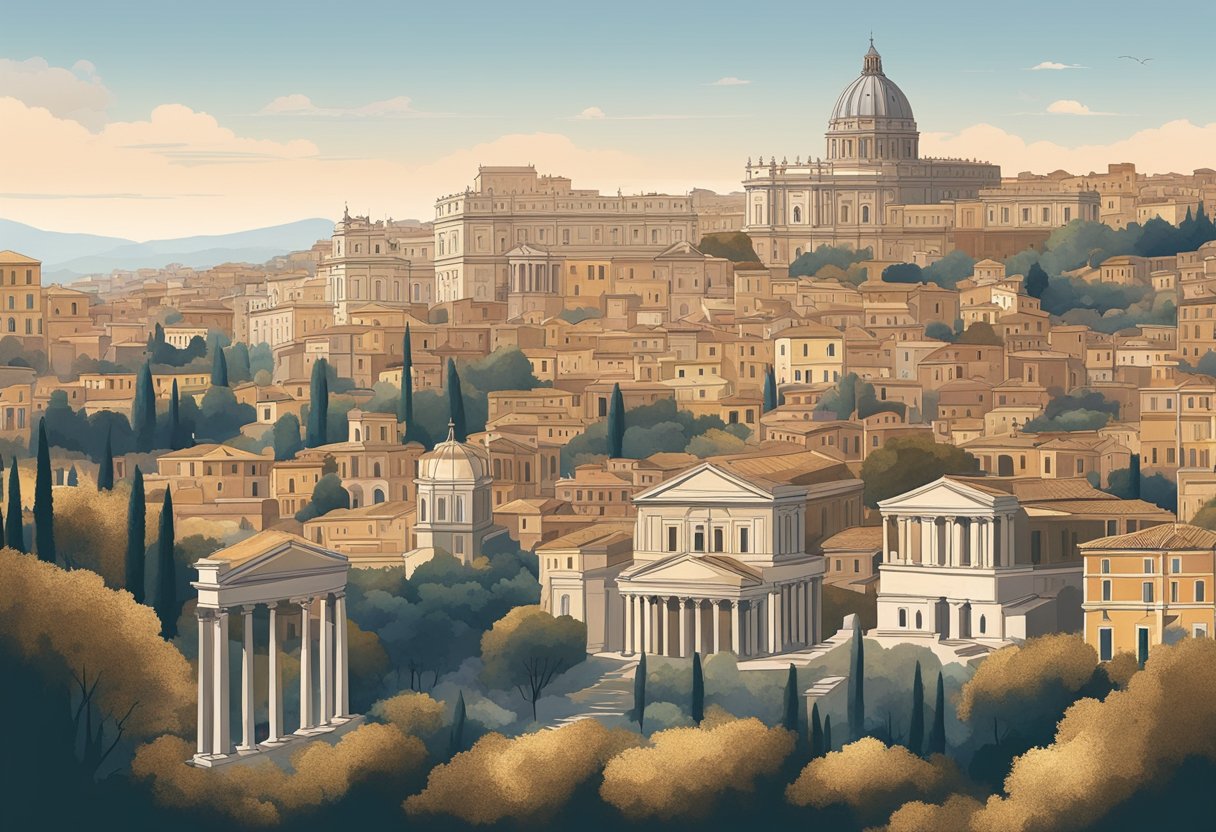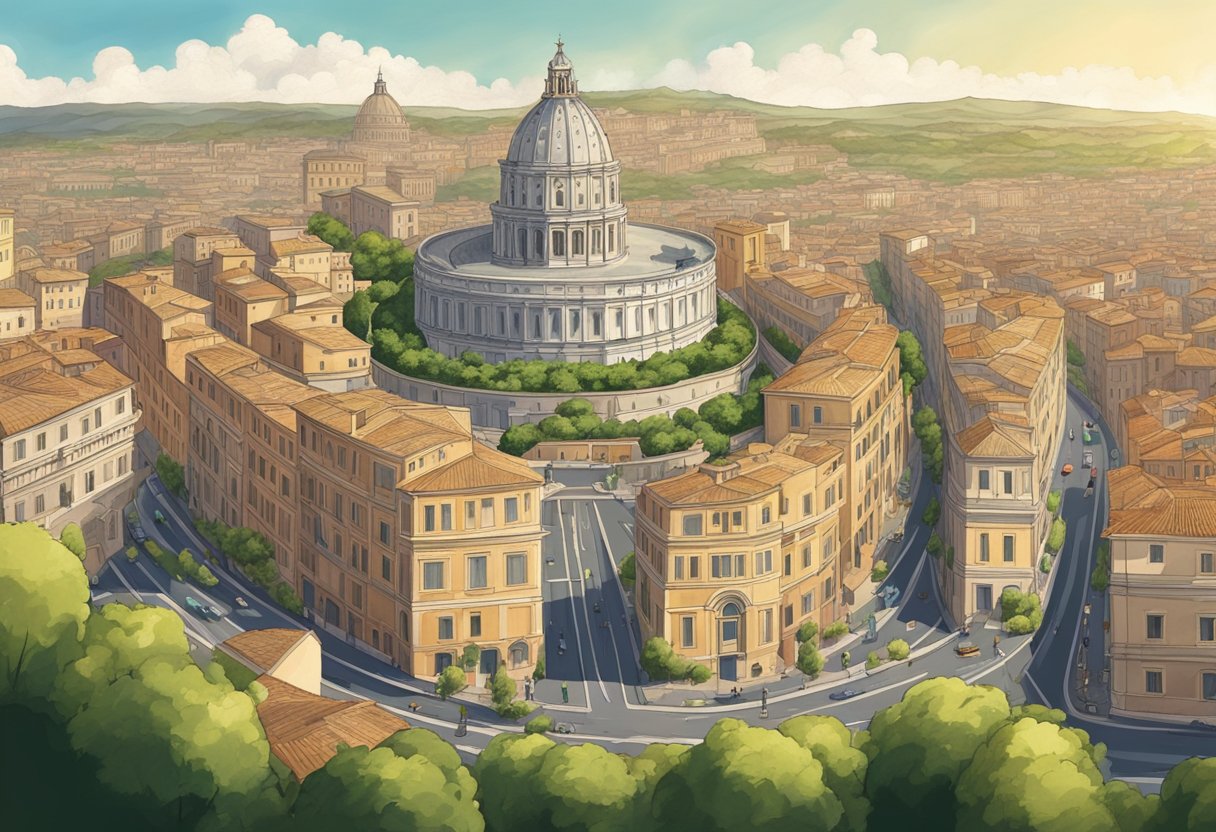Nestled in the heart of the Italian peninsula, Rome is historically celebrated as the city of seven hills. These hills—Palatine, Aventine, Capitoline, Quirinal, Viminal, Esquiline, and Caelian—have been the crux of Rome’s geographical identity since its legendary foundation.
Each hill, with its own unique history and characteristics, played a pivotal role in the ancient city’s urban development. They have continued to shape the city’s layout to this day.

The Seven Hills of Rome are more than just features of topography; they are deeply interwoven with the city’s rich tapestry of history, myth, and power. This association has been crystallized in the works of poets, historians, and scholars through the ages.
The hills’ peaks and valleys have witnessed the evolution of Rome from a small Latin village into the sprawling metropolis and capital of Italy. They reflect both the city’s past magnificence and its modern vibrancy.
Key Takeaways
- Rome stands upon seven distinct hills that are integral to its unique geography and history.
- These hills are foundational to the cultural and historical lore of the city.
- Today, they continue to influence the urban landscape and development of Rome.
Geographical Overview
Rome’s iconic topography is defined by the strategic formation of the land, which includes the storied Seven Hills. They are both historically significant and geographically distinctive, shaping much of the city’s layout.
The Seven Hills
The Palatine Hill is perhaps the most renowned, considered the birthplace of Rome. It sits centrally, rising above the Roman Forum, and is a pivotal part of Rome’s foundation myths. The hill sheltered early settlers from floods and provided a defensible site for the village.
The Aventine Hill, characterized by a more subdued profile, has historically been the seat of the plebeians. Its location offers a strategic vantage point overlooking the Tiber, useful for ancient travel and trade along the river.
The Capitoline Hill has stood as the religious and political heart of Rome, with the Temple of Jupiter and the seat of the Roman government, the Senate. It presents daunting cliffs on one side, contrasting with a gentle slope on the other, leading into the Roman Forum.
The Caelian Hill is to the southeast, a leafy and serene residential district. During ancient times, it was home to high-ranking officials and is now marked by churches and historical ruins.
The Esquiline Hill is the largest and possessed rich soil that supported lush vegetation. In ancient times, it was an area of diverse character, hosting both sumptuous patrician houses and lower-class dwellings.
The Quirinal Hill, named after the god Quirinus, housed temples and public baths. It became a fashionable residential area in the late Republic and holds significance for its association with several deities.
The Viminal Hill, the smallest hill, is often considered more of an offshoot of the Esquiline. It was integrated into the city’s Servian Wall and later became part of Rome’s dense urban fabric.
Collectively, these hills provided natural defense against invaders, dictated the urban development of the city, and contributed to Rome’s identity as a nexus of power, religion, and culture.
Historical Context
The Seven Hills of Rome are emblematic of the city’s layered past, each bearing testimony to its extensive history. From the legendary accounts of its inception to the concrete imprints left by emperors, these hillsides offer a glimpse into the historical depths of ancient Rome.
Founding Myths
According to tradition, the origin of Rome is steeped in myth, with the story of Romulus and Remus serving as the city’s legendary foundation. As the myth goes, these twin brothers, said to be raised by a she-wolf, eventually decided upon the hills near the Tiber as the site for their new city.
However, conflict arose, and Romulus ultimately founded Rome on the Palatine Hill, one of the future Seven Hills, after slaying Remus. This is how, as the story implies, Rome came to be associated with the namesake hill of its reputed founder.
Imperial Significance
Throughout the Roman Empire, the Seven Hills held great significance. Emperors such as Augustus and Domitian built monumental structures that reshaped the city’s topography.
Under Augustus, the Roman Forum reached its peak, becoming the political and social hub of ancient Rome. Meanwhile, Domitian commissioned the building of the palatial complex on the Palatine Hill, a symbol of imperial power.
Emperor Nero’s dramatic reshaping of the city’s landscape post the Great Fire of Rome in AD 64 further highlighted the hills’ centrality in illustrating the grandeur and ambitions of Rome’s rulers.
Archaeological Sites
The Seven Hills of Rome are a treasure trove for archaeologists. Excavations have revealed layers of history buried beneath modern Rome, from the ruins on the Capitoline that once served as the citadel of the earliest Romans to the remnants of opulent houses on the Palatine.
The Colosseum, another iconic archaeological site, though not situated on one of the Seven Hills, remains closely related to the area known as the valley among the Palatine, Esquiline, and Caelian Hills. Each hill continues to be a source of invaluable insights into the lifeways and progressions of one of history’s most significant civilizations.
Cultural Significance
The Seven Hills of Rome hold profound cultural importance, serving as the nexus for a rich tapestry of history, art, and religious devotion. Predominantly, these hills have been a backdrop against which the narrative of Rome’s religious evolution, from paganism to Christianity, has been etched.
Religious Sites
Temples and Churches: Many of the Seven Hills of Rome are significant religious sites, boasting an array of temples and churches.
For example, the Capitoline Hill is renowned for once housing the Temple of Jupiter, a pivotal religious edifice dedicated to the king of the Roman gods. Its legacy is preserved within the Capitoline Museums, a treasure trove of artifacts that illustrate Rome’s mythological and religious past.
Michelangelo’s Influence: The hand of Michelangelo is evident on the Capitoline Hill as well. His architectural genius reshaped the piazza, reinforcing the hill’s standing in the religious and cultural life of the city.
Roman Mythology and Vatican Ties: The interweaving of Roman mythology into the city’s fabric is not relegated to the past.
The presence of the Vatican on the Vatican Hill underscores the enduring legacy of Rome’s hills as focal points of religious reverence. This adjacency highlights a historical continuity from the age of myths to the era of Christian piety.
Jupiter’s Legacy: The preeminent god of Roman mythology, Jupiter, is intimately connected to the Seven Hills, his name forever linked with the grandest of Rome’s ancient sanctuaries. The potent symbolism of these hills resonates in the city’s collective memory and underlines their lasting cultural significance.
Modern Developments

The Seven Hills of Rome, long steeped in history, have witnessed a myriad of developments that marry their ancient grandeur with contemporary needs. Today, these hilly landscapes are zones of juxtaposition, showcasing residential spaces that adhere to modern living standards while preserving historical reverence.
Residential and Political Use
The Palatine Hill, known as the birthplace of Rome, encapsulates this blend of old and new with its residential area featuring critical archaeological sites alongside high-end accommodations.
Here, the intricate layering of Rome’s past and present is most discernible, offering a unique living experience that intertwines the echoes of ancient Rome with the creature comforts of modern life.
The Capitoline Hill, or Campidoglio, has evolved from its ancient roots into a centerpiece of political significance. It houses Rome’s city hall and remains a potent symbol of political power, proudly bearing the marks of storied architects like Michelangelo, who envisioned the hill’s renaissance layout.
Adjacent to the Colosseum, the remnants of the Domus Aurea stand as a testament to the intricate redevelopment of Rome’s historical sites.
Originally Emperor Nero’s vast palace, these ruins are now enveloped by green spaces, displaying how modern conservation practices blend with ancient structures. This facilitates public access and fosters historical education amidst urban expansion.
Frequently Asked Questions
The seven hills of Rome are steeped in history, each contributing to the foundation of one of the world’s most influential cities.
What are the historical significance of the hills of Rome?
The seven hills of Rome are integral to the city’s foundation myths and its actual history. They formed the geographical heart from where ancient Rome grew.
They held temples, public buildings, and patrician homes, symbolizing Rome’s power and prestige.
A detailed examination of this significance is available in the book, The hills of Rome: signature of an eternal city.
Can visitors currently access the locations of the historically recognized hills in Rome?
Yes, visitors can currently access the locations of the historically recognized hills in Rome. These hills are now prominent sites, featuring ruins and historical parks that can be explored on foot.
They provide a glimpse into Rome’s storied past.
What impact did the geography of Rome’s hills have on its early development?
The geography of these hills provided natural defense advantages and delineated the boundaries of the early city.
Control over these elevated zones was essential for security and governance, shaping the expansion and fortification of Rome.
Geological aspects and their role in Rome’s urban fabric are elaborated in a case study provided by the GeoscienceWorld.
How does the biblical reference to the hills relate to the actual geography of Rome?
Biblical references to hills often symbolize power and might, paralleling the way the geography of Rome’s seven hills represented the strength and endurance of the city throughout history.
However, the exact geographic alignment varies between the biblical metaphor and the physical city of Rome.
Are there any misconceptions regarding the number of hills in Rome?
There are misconceptions about the number of hills in Rome, with sometimes more than the widely recognized seven being claimed.
However, the traditional understanding of Rome’s topography is centered around these seven hills: the Aventine, Caelian, Capitoline, Esquiline, Palatine, Quirinal, and Viminal.
What are the contemporary ways to explore the hills of Rome?
In contemporary times, the hills can be explored through guided tours. These tours are available either on foot or by bus. They offer historical insights and panoramic views of the city.
Technology has also enabled virtual explorations. These can provide an interactive experience for those unable to visit in person.
